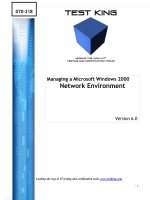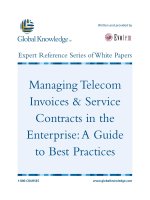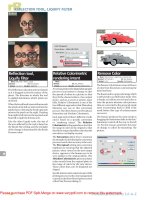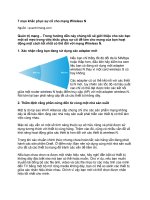BMC Control-M 7: A Journey from Traditional Batch Scheduling to Workload Automation doc
Bạn đang xem bản rút gọn của tài liệu. Xem và tải ngay bản đầy đủ của tài liệu tại đây (14.19 MB, 534 trang )
www.it-ebooks.info
BMC Control-M 7: A Journey
from Traditional Batch
Scheduling to Workload
Automation
Master one of the world's most powerful enterprise
workload automation tools – BMC Control-M 7 - using
this book
Qiang Ding
BIRMINGHAM - MUMBAI
www.it-ebooks.info
BMC Control-M 7: A Journey from Traditional Batch
Scheduling to Workload Automation
Copyright © 2012 Packt Publishing
All rights reserved. No part of this book may be reproduced, stored in a retrieval
system, or transmitted in any form or by any means, without the prior written
permission of the publisher, except in the case of brief quotations embedded in
critical articles or reviews.
Every effort has been made in the preparation of this book to ensure the accuracy
of the information presented. However, the information contained in this book is
sold without warranty, either express or implied. Neither the author, nor Packt
Publishing, and its dealers and distributors will be held liable for any damages
caused or alleged to be caused directly or indirectly by this book.
Packt Publishing has endeavored to provide trademark information about all of the
companies and products mentioned in this book by the appropriate use of capitals.
However, Packt Publishing cannot guarantee the accuracy of this information.
First published: October 2012
Production Reference: 1041012
Published by Packt Publishing Ltd.
Livery Place
35 Livery Street
Birmingham B3 2PB, UK.
ISBN 978-1-84968-256-5
www.packtpub.com
Cover Image by Anvar Khodzhaev ()
www.it-ebooks.info
Credits
Author
Qiang Ding
Reviewers
Bentze Perlmutter
Robert Stinnett
Acquisition Editor
Dhwani Devater
Technical Editor
Lubna Shaikh
Copy Editors
Brandt D'mello
Insiya Morbiwala
Laxmi Subramanian
Project Coordinator
Vishal Bodwani
Proofreaders
Lesley Harrison
Lynda Sliwoski
Indexer
Rekha Nair
Graphics
Nilesh R. Mohite
Manu Joseph
Production Coordinator
Arvindkumar Gupta
Cover Work
Arvindkumar Gupta
www.it-ebooks.info
About the Author
Qiang Ding (Melbourne, Australia) has been working within the Control-M space
for more than a quarter of his life. During his early days at BMC Software, Qiang
resolved countless number of critical technical issues for Control-M customers
around the world from Fortune 500 companies to government organizations. In
recent years, Qiang has travelled hundreds thousands of miles around Australia
and the North AP area to help many organizations to design, manage, and optimize
their batch workload automation environment and to extend his passion to others by
delivering Control-M trainings to end users and BMC Partners.
Currently Qiang is temporary living in Sydney and working on a enterprise wide
Control-M migration and Consolidation project for a major Australian bank. He
enjoys working with other experts in the eld and is constantly involved in nding
ways for making improvements to the batch environment that he works on.
www.it-ebooks.info
Acknowledgement
There are many people that I would like to thank for their contribution to the
creation of this book and to those who have reviewed, proofread, commented,
and provided quotes.
On a greater scale, I would like to thank Bentze Perlmutter and Graeme Byrnes,
who originally taught me every technical detail of Control-M, followed by Bruce
Roberts, who in the recent years embraced my Control-M knowledge from a pure
technical level into business level. I also would like to thank people who I worked
for and worked with in the past few years, those who had a faith in me and gave me
the opportunity and trust, including Allen Lee, Amy You, Angel Wong, Bao Ling,
Louis Cimiotti, Chris Cunningham, Craig Taprell, Curtis Eddington, David Timms,
Digby Pritchard, Doug Vail, Ian Jones, Jason St. Clair, Jeffrey Merriel, Jim Darragh,
Matthew Sun, Min Yuan, Moshe Miller, Rabin Sarkar, Rick Brown, Shaun Kimpton,
Stephen Donnelly, Tom Geva, Tristan Gutsche, Xianhua Peng, Yuan Yuan, and Ze'ev
Gross. Last but not least, I would like to thank my friend Mike Palmer who inspired
me and guided me in every aspect of my life.
For all those who have provided support and guidance over the years and if I have
yet to mention your name, I sincerely apologize.
www.it-ebooks.info
About the Reviewers
Bentze Perlmutter has 15 years of IT experience, working in various companies
and holding positions in operations, QA, technical support, engineering, systems
management, and production control.
His main area of expertise is batch and workload automation using tools such as
Control-M and AutoSys. He has worked on complex projects requiring evaluation
of solutions, design and planning, implementation, administration, and on-going
support within large organizations, mainly in the nancial industry.
Robert Stinnett has worked with automation systems on various platforms from
mainframe to distributed since 1992. He has been using Control-M since 2003 when
he was the lead for bringing it to CARFAX, the leading provider and pioneer of
vehicle history reports, where he has worked for the past 10 years.
Robert is active in many Control-M communities, has given presentations at various
conferences on the capabilities and cost-benets of using an automated workload
management platform, and has written a number of open-source utilities to help take
advantage of and extend Control-M's capabilities on the distributed side.
One of the next big things he sees for automation systems is their integration with
Cloud. He is currently working on projects that explore how Cloud can be used for
providing capacity on demand as well as providing redundancy and scalability to
existing automation and scheduling implementations.
Robert is also an active member of the Computer Measurement Group where he sees
the role of automation in IT as one of the major reasons to have a sound performance
and capacity management program in place to help manage the continuing
technological evolution taking place in businesses.
He can be reached at
www.it-ebooks.info
www.PacktPub.com
Support les, eBooks, discount offers and more
You might want to visit www.PacktPub.com for support les and downloads related to your book.
Did you know that Packt offers eBook versions of every book published, with PDF and ePub
les available? You can upgrade to the eBook version at www.PacktPub.com and as a print
book customer, you are entitled to a discount on the eBook copy. Get in touch with us at
for more details.
At www.PacktPub.com, you can also read a collection of free technical articles, sign up for a range
of free newsletters and receive exclusive discounts and offers on Packt books and eBooks.
Do you need instant solutions to your IT questions? PacktLib is Packt's online digital book library.
Here, you can access, read and search across Packt's entire library of books.
Why Subscribe?
• Fully searchable across every book published by Packt
• Copy and paste, print and bookmark content
• On demand and accessible via web browser
Free Access for Packt account holders
If you have an account with Packt at www.PacktPub.com, you can use this to access PacktLib
today and view nine entirely free books. Simply use your login credentials for immediate access.
Instant Updates on New Packt Books
Get notied! Find out when new books are published by following @PacktEnterprise on
Twitter, or the Packt Enterprise Facebook page.
www.it-ebooks.info
www.it-ebooks.info
Table of Contents
Preface 1
Chapter 1: Get to Know the Concept 7
Introduce batch processing 8
The history of batch processing 8
Batch processing versus interactive processing 11
Time-based batch- and event-driven batch 13
Is this the end for batch processing? 14
Running batch processing tasks 16
Automating batch processing 21
Basic elements of a job 21
What to trigger 22
When to trigger (Job's scheduling criteria) 22
Dependencies (Job's predecessors and dependents) 22
More advanced features of scheduling tools 24
Ability to generate notications for specied events 24
Ability to handle an external event-driven batch 24
Intelligent scheduling – decision-making based on predened conditions 25
Security features 25
Additional reporting, auditing, and history tracking features 26
Centralized enterprise scheduling 26
Challenges in today's batch processing 26
Processing time 31
Batch window length 31
Batch monitoring and management 32
Cross-time zone scheduling 32
Resource utilization 32
Maintenance and troubleshooting 33
Reporting 33
Reacting to changes 33
The solution 34
Processing time and resource utilization 35
Batch monitoring and management 35
www.it-ebooks.info
Table of Contents
[ ii ]
Cross-time zone scheduling 36
Maintenance and troubleshooting 37
Reporting 37
Reacting to changes 37
From batch scheduling to workload automation 38
Batch scheduling: Static scheduling 39
The Workload Automation concept 40
Dynamic batch processing with virtualization technology and
Cloud computing 41
Integration with real-time system, workload reusability 43
Summary 45
Chapter 2: Exploring Control-M 47
Control-M overview 48
Control-M road map 48
Key features 49
Supported platforms 50
The Control-M way 52
Control-M job 52
Submitting jobs 53
Post processing 54
From the user's perspective - Control-M/Enterprise Manager 54
Control-M Enterprise Manager GUI Client 55
Control-M Desktop 56
Control-M Conguration Manager 58
Reporting Facility 58
Control-M's Optional Features 60
Control-M Control Modules 60
Control-M/Forecast and BMC Batch Impact Manager 61
BMC Batch Discovery 63
Control-M Architecture and Components 64
Control-M/Enterprise Manager 66
Control-M/Enterprise Manager Server Components 66
Control-M/Server 69
Control-M/Server processes 70
Control-M/Agent 73
AG: Agent Listener, Request Handler 74
AT: Agent Tracker 74
AR: Agent Router Process 74
UT: Utility Process 75
Agentless Technology 75
Control-M/Control Modules 76
How do Organizations Work With Control-M? 76
Where to Start? 78
General Product information 78
www.it-ebooks.info
Table of Contents
[ iii ]
Ofcial Education and Certication 79
Getting a Job in Control-M 80
Summary 82
Chapter 3: Building the Control-M Infrastructure 83
Three ages to workload automation 84
Stone age 84
Iron age 86
Golden age 88
Planning the Batch environment 88
Control-M sizing consideration 89
Total number of batch jobs run per day 89
Total number of job execution hosts 91
Number of datacenters 91
Amount of concurrent GUI users 92
Use Control-M/Agent or go Agentless 93
Production, development, and testing 95
Control-M high availability requirements 96
Control-M in a clustered environment 97
Control-M/Server mirroring and failover 99
Control-M node group 101
High availability by virtualization technology 102
Pre-installation technical considerations 104
Environment compatibility 104
Choices of database 105
System conguration requirements 106
Storage space related considerations for Control-M 110
Firewall requirements 111
Between Control-M/Enterprise Manager Clients and Server Components 112
Between Control-M/Enterprise Manager Server Components and Control-M/Server 114
Between Control-M/Server and Control-M/Agent 115
Agentless remote hosts 115
Database 116
Last things to make sure of before the installation starts 117
Installation 118
Install Control-M/Enterprise manager server components 122
Download and execute the check_req script 122
Create a Linux user and allocate space for Control-M/EM 125
Conguring the system to meet installation requirements 126
Preparing the installation media 129
Installation 130
Post-installation tasks 136
Install Control-M/Enterprise manager clients 137
Preparing the installation media 138
Installation 138
Post-installation tasks 141
www.it-ebooks.info
Table of Contents
[ iv ]
Installing Control-M/Server 142
Installation in Linux environment 142
Installation in a Windows environment 151
Installing Control-M/Agent 158
Installation in Linux environment 158
Installation in a Windows environment 164
Summary 165
Chapter 4: Creating and Managing Batch Flows with
Control-M GUI 167
The Control-M way – continued 168
Contents of a job denition 168
"What" #1: job type 169
"What" #2: task type 170
"Who" #1 – owner of the job 171
"Who" #2 – author of the job 171
"Where" #1 – job's execution host 172
"Where" #2 – storing job denitions 172
"When" #1 – job's scheduling date 175
"When" #2 – time frame for job submission 177
"When" #3 – cyclic jobs 178
"When" #4 – manual conrmation jobs 179
"When" #5 – job condition 179
"When" #6 – resource and job priority 180
"When" #7 – time zone 182
What happens right after the job's execution is completed? 182
Autoedit facility 184
Lifecycle of a job 185
Write/Load, Upload/Download, Order/Force, and Hold 185
State of a job 187
New Day Procedure (NDP) 188
Active job ordering 189
Active job cleaning 189
Control-M Date and Odate 190
User Daily 190
Working with Control-M Desktop and EM GUI Client 191
Control-M Desktop – the Workspace 192
Control-M/EM GUI client – Active ViewPoint 193
Dening and running jobs 195
Creating the rst job – Hello World! 195
Write, Upload, and Order the job 198
Monitor and Control the Job 201
Modifying and rerunning the job 205
A more complicated job ow 211
Dening SMART table, application, and group 214
Building cyclic jobs 216
Utilizing the Autoedit facility 224
www.it-ebooks.info
Table of Contents
[ v ]
Linking jobs with job conditions 228
Dening Global Conditions 233
Creating calendars 236
Adding job post-processing and job steps 239
Working with Resources 243
Having a "Start" job 245
Summary 249
Chapter 5: Administrating the Control-M Infrastructure 251
Additional component installations 252
Installation of BIM and Forecast 253
Installation 253
Post-installation tasks 254
Conguring BIM web interface 255
Installation of Control Modules 257
Pre-installation considerations 258
Installation – Control-M for database 259
Installation – Control Module for Advanced File Transfer 260
Installation – Control-M Business Process Integration Suite 262
Post-installation tasks 264
Expanding and updating the batch environment 267
Ongoing installation of Control-M/Agents and Control Modules 267
Installing multiple Control-M/Agents on the same host 269
Dening Agentless remote hosts 272
Unix/Linux remote host (using SSH) 273
Windows remote host (using WMI) 278
Applying Control-M x packs and patches 280
When to apply x packs and patches 281
How to apply x packs and patches 282
Fix pack and patch installations in our environment 283
Installing additional Control-M GUI clients 285
Frequent administration tasks 288
Stop/start components 288
Manually stop/start components 289
Conguring automatic startup script 297
Dening additional GUI users and groups 298
Authorization of conguration items 298
Customizing Control-M GUI 302
Summary 303
Chapter 6: Advanced Batch Scheduling and Management 305
Importing existing batch processing tasks 306
Importing CRON jobs into our environment 306
For Host ctm-demo-linux-01 307
For Host ctm-demo-linux-02 310
www.it-ebooks.info
Table of Contents
[ vi ]
Enhance the le processing batch ow 312
Control-M lewatch 314
Technical background 314
Dening lewatch job 322
Advanced le transfer 327
Technical background 327
Implementing AFT jobs 330
Control-M for database 336
Technical background 336
Implementing Database CM jobs 337
Advanced batch management 342
ViewPoints 342
Viewing jobs in Active ViewPoint 342
Performing job actions in Active ViewPoint 344
The Time Machine – Archived ViewPoint 350
Creating ViewPoint 351
Forecasting 354
Job scheduling plan forecasting 354
Forecast ViewPoint 356
Managing batch ows as services 357
Dening services 358
Monitoring services 361
Control-M reporting facility 364
Type of reports 364
Creating a report 366
Automated reporting 367
The emreportcli utility 367
Reporting job 368
Summary 370
Chapter 7: Beyond Everyday Administration 371
GUI alternative—command-line utilities 372
Control-M/Server utilities 372
Control-M/Agent utilities 374
Securing the environment 374
User authentication: External authentication 375
Conguring LDAP parameters 376
Converting existing GUI users to authenticate with LDAP 378
Associating EM user groups with LDAP groups 379
User privilege: Control-M/Server security 380
Dening group-level security 381
Dening user-level security 382
Enabling Control-M/Server security 383
Job ordering and submission: User exit 384
Job execution: Control-M/Agent security 386
Security for Windows Control-M/Agents 386
www.it-ebooks.info
Table of Contents
[ vii ]
Security for Unix/Linux Control-M/Agents 387
Control-M/Server utility authorizations 389
Inter-component communication—rewall 390
Between Control-M/EM server components and GUI clients 390
Between Control-M/Server and Agents 391
Inter-component Communication—SSL 393
Implementing SSL 394
Auditing 396
Enabling and conguring auditing 397
Producing auditing report 398
Control-M mirroring and failover 399
Pre-implementation tasks 400
Installing and conguring the secondary Control-M/Server 400
Conguring Control-M/Agents 401
Testing the secondary Control-M/Server 403
Initializing mirroring and failover 404
Switching to mirroring and failover 405
Switching over to mirroring 406
Switching over to failover 407
Recovering from mirroring and failover 408
Recovering from mirroring 409
Recovering from failover 410
Perfecting Control-M 410
Housekeeping 410
Active environment-related housekeeping 411
Database-related housekeeping 415
Filesystem-related housekeeping 418
Component status checking 419
NDP tuning 420
Things happening during NDP 420
Shortening NDP 424
Other congurations items 427
Control-M/EM: MaxOldDay and MaxOldTotal 427
Control-M/EM: Default AverageTime 428
Control-M/Server: New Day Time 428
Control-M/Server: Simple Mail Transfer Protocol parameters 429
Control-M/Server: shout destination tables 430
Summary 431
Chapter 8: Road to Workload Automation 433
Integrating Control-M with business processes 434
Building the environment 436
Interacting with BPI interfaces 438
Technical background 439
Dening an account 440
Triggering job ordering 443
www.it-ebooks.info
Table of Contents
[ viii ]
Taking parallel processing to the next level 445
Merging the two le processing job ows 446
Enabling parallel processing 448
Implementing control module for BPI jobs 454
Technical background 455
Dening accounts 456
Creating jobs 459
Updating the quantitative resource 465
End-to-end testing 466
Managing batch jobs as workloads 470
Running jobs in node groups 471
Technical background 471
Creating node groups 472
Making necessary changes to the environment and jobs 475
Putting into action 479
Dening and managing workloads 480
Technical background 481
Dening workloads 483
Putting into action 486
Into the Cloud 489
Technical background 491
Dening accounts 494
Dening jobs 496
Modifying the le processing job ow 497
Dening CM for Cloud jobs 498
End-to-end testing 500
Summary 502
Index 503
www.it-ebooks.info
Preface
Control-M is one of the world's most wildely used enterprise class batch workload
automation product produced by BMC Software. With a strong knowledge of
Control-M, you will be able to use the tool to meet ever growing batch processing
needs. However, there is no book that can guide you to implement and manage
this powerful tool successfully until now. With this book, you will quickly master
Control-M, and be able to call yourself "a Control-M" specialist!
This book will lead you into the world of Control-M, and guide you to implement
and maintain a Control-M environment successfully. By mastering this workload
automation tool, you will see new opportunities opening up before you.
With this book, you will be able to take away and put into practice knowledge from
every aspect of Control-M implementation, administration, design, and management
of Control-M job ows, and more importantly how to move into workload
automation, and let batch processing utilize the cloud.
You will start off with the history and concept of batch processing and how recenty
it got evolved into workload automation, and then get an understanding of how
Control-M ts into the big picture. Then we will look more in depth at the technical
details of the tool - How to plan, install, use, as well as manage a Control-M
environment, and nally look at how to leavage the tool to meet the already
sophiscated and ever growing business demand. Throughout the book, you will
learn important concepts and features of Control-M through detailed explainations
and examples, as well as learn from the author's experience, accumulated over many
years. By the end of the book, you will be set up to work efciently with this tool,
and also understand how to utilize the latest features of Control-M.
www.it-ebooks.info
Preface
[ 2 ]
What this book covers
Chapter 1, Get To Know the Concept, gives a good understanding of the concept of
batch processing and centralized enterprise scheduling – what were the challenges
and why they exist today. Besides that, it also provides an overall view of the latest
concept – workload automation.
Chapter 2, Exploring Control-M, gives an overview of the features of Control-M,
important concepts, and reviews the architecture of Control-M.
Chapter 3, Building the Control-M Infrastructure, introduces the concept of the "Three
Ages" to archive workload automation, and then looks at the different requirements
and challenges at each stage. It also talks about the sizing and the technical
considerations that are necessary for building a solid batch infrastructure. Finally,
it shows how to get started into the technical details and prepare machines and the
environment for the Control-M implementation.
Chapter 4, Creating and Managing Batch Flows with Control-M GUI, looks at the
important job scheduling concepts of Control-M in depth and applies them by
defning some simple jobs in Control-M Desktop, and manages them using the
Control-M/EM GUI client. Then it goes one step further by defning a complete batch
fow to meet a scheduling requirement.
Chapter 5, Administrating the Control-M Infrastructure, starts with installing the
additional Control-M components – BIM and Forecast, followed by discussing the
tasks involved in expanding and updating the Control-M environment. It talks about
the different methods of performing regular installation tasks, such as applying
x packs and installing Control-M/EM GUI clients, as well as demonstrates how
to dene Agentless remote hosts in both Linux and Windows environments.
Towards the end, it explains how to perform some must-known administration
tasks, including stop/start Control-M components, dene Control-M/EM user
authorizations, and customize the GUI.
Chapter 6, Advanced Batch Scheduling and Management, shows to add more jobs to
Control-M by bulk load jobs from the crontab. It explains how to transform le
processing job ow from time-based scheduling into event-driven scheduling,
and improve some part of the job ow by using additional Control Modules. After
dening the jobs, it revisits the Control-M/EM GUI client to discover more GUI
features, such as advanced functionalities offered in ViewPoints and archived
ViewPoints. It also gives an overview of how to use BIM and Forecast to proactively
monitor jobs and estimate potential impacts, by creating What-if scenarios. Towards
the end, it visits the Reporting Facility, takes a look at each available report type, and
discusses how to automate reporting.
www.it-ebooks.info
Preface
[ 3 ]
Chapter 7, Beyond Everyday Administration, focuses on the administration side of
Control-M but in more depth. It starts with looking at the command-line utilities
that can be used to affect the active environment. More importantly, it reviews the
different security options provided by Control-M, as well as a demonstrates the
Control-M mirroring and failover. After having secured the environment, it took us
to the new level by perfecting the Control-M environment.
Chapter 8, Road to Workload Automation, makes a number of improvements to the le
processing job ow from both the integration and performance aspects, by using the
cutting-edge Control-M add-on features. These include enabling the job fow to have
exposure to external applications, by using the BPI web service interface, integration
with ESB with BPI web service and message queue jobs, rendering the processing
truly parallel, and implementing load balancing. Towards the end, it turns our
processing ow into workloads, and taps into the power of cloud computing to for
limitless processing.
Who this book is for
This book is suitable for professionals who are beginning to use Control-M, but who
also have some general IT experience, such as knowing the concepts of computer
system architecture, operating systems, databases, basic computer networking. Some
entry level skills in scripting languages will be of help along the way.
Also for those who are from the mainframe environment or moving from other
schedulers to Control-M, you can use this book as a starting point.
Conventions
In this book, you will nd a number of styles of text that distinguish between
different kinds of information. Here are some examples of these styles, and an
explanation of their meaning.
Code words in text are shown as follows: "By 12:00am, there are ten orders
generated in total. Program
PROCESS_ORDER is set to trigger at this time of the
day to process them".
A block of code is set as follows:
<soapenv:Envelope xmlns:soapenv=" />envelope/" xmlns:sch=" /> <soapenv:Header/>
<soapenv:Body>
<sch:request_order_force>
www.it-ebooks.info
Preface
[ 4 ]
<sch:user_token>?</sch:user_token>
<sch:force_it>yes</sch:force_it>
<sch:control_m>CTM_LINUX</sch:control_m>
<sch:table_name>TEST</sch:table_name>
<sch:odate>ODAT</sch:odate>
</sch:request_order_force>
</soapenv:Body>
</soapenv:Envelope>
Any command-line input or output is written as follows:
# pwd
/usr/java/jboss-6.0.0.Final/bin
# ./run.sh -Djboss.as.deployment.ondemand=false -b 0.0.0.0
New terms and important words are shown in bold. Words that you see on the
screen, in menus or dialog boxes for example, appear in the text like this: " One to
one relationship simply means the jobs run one after another, for example, when Job
A is completed, then Job B starts.".
Warnings or important notes appear in a box like this.
Tips and tricks appear like this.
Reader feedback
Feedback from our readers is always welcome. Let us know what you think about
this book—what you liked or may have disliked. Reader feedback is important for us
to develop titles that you really get the most out of.
To send us general feedback, simply send an e-mail to
,
and mention the book title through the subject of your message.
If there is a topic that you have expertise in and you are interested in either writing
or contributing to a book, see our author guide on
www.packtpub.com/authors.
www.it-ebooks.info
Preface
[ 5 ]
Customer support
Now that you are the proud owner of a Packt book, we have a number of things to
help you to get the most from your purchase.
Errata
Although we have taken every care to ensure the accuracy of our content, mistakes
do happen. If you nd a mistake in one of our books—maybe a mistake in the text or
the code—we would be grateful if you would report this to us. By doing so, you can
save other readers from frustration and help us improve subsequent versions of this
book. If you nd any errata, please report them by visiting
ktpub.
com/support
, selecting your book, clicking on the errata submission form link, and
entering the details of your errata. Once your errata are veried, your submission
will be accepted and the errata will be uploaded to our website, or added to any list
of existing errata, under the Errata section of that title.
Piracy
Piracy of copyright material on the Internet is an ongoing problem across all media.
At Packt, we take the protection of our copyright and licenses very seriously. If you
come across any illegal copies of our works, in any form, on the Internet, please
provide us with the location address or website name immediately so that we can
pursue a remedy.
Please contact us at
with a link to the suspected
pirated material.
We appreciate your help in protecting our authors, and our ability to bring you
valuable content.
Questions
You can contact us at if you are having a problem with
any aspect of the book, and we will do our best to address it.
www.it-ebooks.info
www.it-ebooks.info
Get to Know the Concept
Before we dive deep into the concept of Control-M, let's relax a little bit by beginning
with a brief lesson on the history of batch processing. In the rst chapter, we will
be looking at the basic fundamentals of batch processing and the ever growing
technical and business requirements, as well as related challenges people are facing
in today's IT environment. Based on that, we will look at how can we overcome these
difculties by using centralized enterprise scheduling platforms, and discuss the
features and benets of those platforms. Finally, we will get into the most exciting
part of the chapter, talking about a brand new concept, that is, workload automation.
By keeping these key knowledge points in mind, you will nd it easy to understand
the purpose of each Control-M feature later on in the book. More importantly,
adopting the correct batch concepts will help you build an efcient centralized batch
environment and be able to use Control-M in the most effective way in the future.
By the end of this chapter, you will be able to:
• Explain the meaning of batch processing and understand why batch
processing is needed
• Describe the two major types of batch processing
• List the challenges of batch processing in today's IT environment
• Outline the benets of having a centralized batch scheduling tool
• Name different job roles and responsibilities in a centralized batch
environment
• Understand why workload automation is the next step for batch scheduling
www.it-ebooks.info
Get to Know the Concept
[ 8 ]
Introduce batch processing
We hear about hot IT topics everyday, everywhere. Pick up a tech magazine, visit an
IT website, or subscribe to a weekly newsletter and you will see topics about cloud
computing, SOA, BPM/BPEL, data warehouse, ERP—you name it! Even on TV and
at the cinemas, you may see something such as an "Iron Man 2 in theatres soon +
Sun/Oracle in data centre now" commercial. In the recent years, IT has become a
fashion more than simply a technology, but how often do you hear the words "batch
processing" mentioned in any of the articles or IT road shows?
The history of batch processing
Batch processing is not a new IT buzz word. In fact, it has been a major IT concept
since the very early stage of electronic computing. Unlike today, where we can run
programs on a personal computer whenever required and expect an instant result,
the early mainframe computers could handle non-interactive processing only.
In the beginning, punched cards were used as the media for storing data (refer to the
following). Mainframe system programmers were required to store their program and
input data onto these cards by punching a series of dots and pass them to the system
operators for processing. Each time the system operators had to stack up the program
cards followed by the input data cards onto a special card reader so the mainframe
computer could load the program into memory and process the data. The execution
could run for hours or days and it would stop only when the entire process was
complete or in case an error occurred. Computer processing power was expensive
at that time. In order to minimize a computer's idle time and improve efciency, the
input data for each program was normally accumulated in large quantities and then
queued up for processing. In this manner, lots data could be processed at once, rather
than frequently re-stacking the program card multiple times for each small amount of
input data. Therefore, the process was called batch proc
essing.
www.it-ebooks.info









